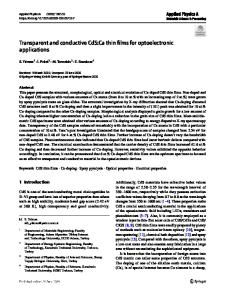Highly conductive and transparent Ti-doped zinc oxide thin films
- PDF / 128,714 Bytes
- 9 Pages / 596 x 842 pts (A4) Page_size
- 108 Downloads / 468 Views
H10.11.1
Highly conductive and transparent Ti-doped zinc oxide thin films Yang-Ming Lu, Shu-I Tsai and Chen-Min Chang Department of Electronics Engineering, Kun Shan University of Technology, Tainan, Taiwan,No.949,Da-Wan Rd., Yung-Kang City, Tainan Hsien,71003 Taiwan, R.O.C. TEL:886-6-2050208,886-6-911653688; FAX:886-6-2731863 Email:[email protected] ABSTRACT The properties of ZnO thin film are currently of great commercial and scientific interest due to its particular properties such as highly conductive, transparent as well as chemical stability and nontoxic. The Ti doping ZnO thin films were deposited by simultaneously magnetron co-sputtering from both Zn and Ti targets in a mixture of oxygen and argon gases onto heated Corning 7059 glass substrates in this study. The experimental results show that deposition rate of ZnO films are strongly dependent on DC power of Ti target. The growth rate initially increases and changes to decrease when the DC power of Ti target further rises. The content of Ti in the ZnO films increases with the applied DC power of Ti target. The lattice constant of ZnO (002) increases with DC power of Ti target due to incorporated Ti into the lattice of ZnO. The crystalline size becomes smaller when the DC power of Ti target was raised. The visible transmittance is a little lowered when slight Ti incorporated but still average maintains above 80%. The lowest resistivity of undoped ZnO film obtained in this study is 4.14×10-3 ohm-cm and further decreased to 1.02×10-3 ohm-cm after being doped a trace of Ti.
INTRODUCTION Thin film material with good electrical conductivity and high optical transparency will be critical for next-generation flat-panel displays (FPD), photovoltaic cells, organic light-emitting diodes (OLEDs), energy -efficiency windows, and other opto-electronic technologies1 . Although transparent conducting oxides (TCOs) such as Sn-doped In2 O3 (ITO) and F-doped SnO 2 are used extensively2 ,their electrical and optical characteristics are inadequate for future
Downloaded from http:/www.cambridge.org/core. University of Warwick, on 11 Dec 2016 at 16:04:12, subject to the Cambridge Core terms of use, available at http:/www.cambridge.org/core/terms. http://dx.doi.org/10.1557/PROC-769-H10.11
H10.11.2
application1 ,and further under- standing the relationship between their scientific properties and exceeding complex microstructures still need to be explored. Recent advances in the TCO material including new ZnO conductors
3
and other candidate
materials 4-5 have got progress. The properties of ZnO thin films are currently of great commercial and scientific interest. Zinc oxide with wurtzite crystal structure is a ⅡⅥ semiconductor material and has direct band gap. The high melting point, stability and excitation energy make it a promising ultraviolet (UV) and blue optoelectronic material6 . Recently, zinc oxide films have attracted interest as a transparent and conductive material due to its many advantages: (1) cheap and abundant raw starting materials (2) possible large
Data Loading...











